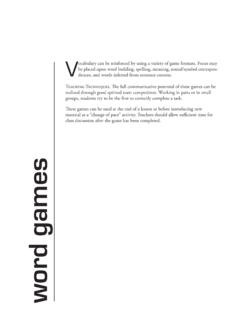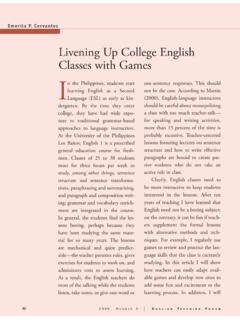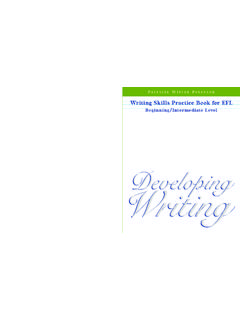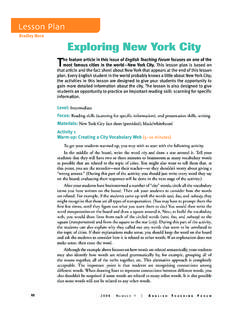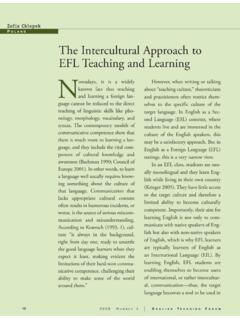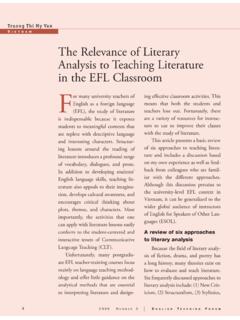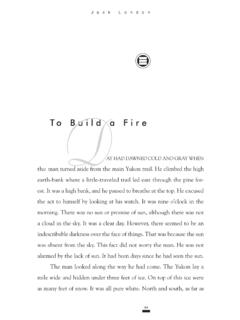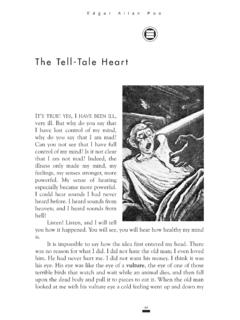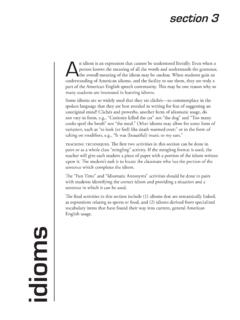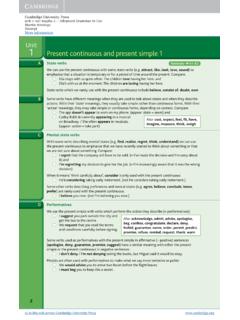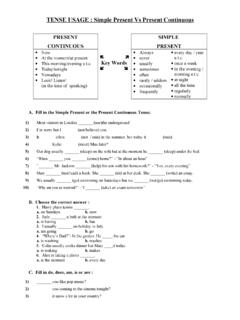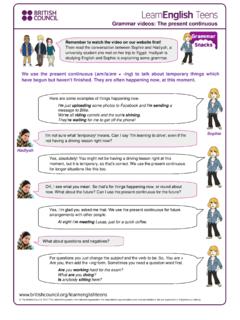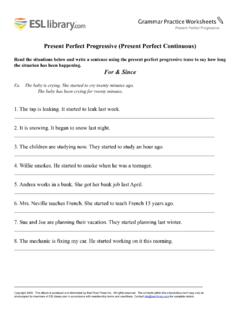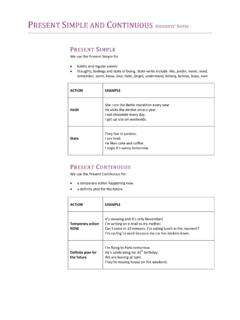Transcription of “I’M STANDING ON A CORNER. ACTIVITIES FOR THE …
1 I M STANDING ON A CORNER. ACTIVITIES FOR THE present progressive LEVEL High-Beginner to Advanced LANGUAGE FOCUS Speaking, writing, grammar (primary focus); listening (secondary focus) GOALS Students will increase their understanding of the present progressive tense in two ACTIVITIES . The first activity places students in the role of party host and a lost guest where students will develop both their speaking and listening skills through a map reading exercise. In the second activity, students will practice their writing skills through writing a letter home about their study abroad in the United States. MATERIALS x Teacher: whiteboard/chalkboard, markers or chalk, infographic (Appendix 1), city map (Appendix 2), location cards (Appendix 3), a timing device. x Students: pencils or pens, notebooks or writing paper. PREPARATION 1. Read through all the materials carefully. 2. The first activity is a speaking activity. The second activity is a writing activity.
2 These ACTIVITIES can be done in the same class, or you can choose one activity depending on the needs of your classroom. 3. Students work in pairs for the first activity. Print one map (Appendix 2) and one set of location cards (Appendix 3) for each pair of students. If you plan to do the activity twice, with students switching roles, have enough copies of the map and location cards so that each student receives one of each 4. The speaking activity has an opportunity for expansion. If you decide to do this expansion students will choose a local landmark that they can describe to their partner. Prior to class brainstorm some locations with which students are familiar. If students have trouble deciding on a landmark, they can choose from those prepared prior to class. 5. This activity uses pair/group work. If you would like to learn more on how to pair or group students see the April 2015 Teacher s Corner. 6. ACTIVITY 1 PROCEDURES 1.
3 Place the present progressive Infographic (Appendix 1) on the board. Point to the green box on the infographic highlighting actions happening now. Ask the students: a. What are you doing right now? i. In their answers stress the use of will + be+ verb(ing) I am studying English. 2. Have the students practice the form by brainstorming an action. For example: riding a bike. Tell the students to keep their action a secret. 3. Have a volunteer come to the front of the class and act out their action to the class. 4. The other students should guess the action using the present progressive You are riding a bicycle. 5. After students have had time to practice the present progressive structure, have the students brainstorm a location in the city that is well known. Tell the students to keep the location a secret. 6. Next, have the students stand-up if possible to move around the room and form pairs. If not, have them pair up with a partner sitting nearby.
4 In each group, designate one student as A and the other student as B. 7. Pass out the map (Appendix 2) to student A. On the map are a number of empty spaces. Have each student A choose an empty space and mark it as their house. Instruct them to keep it secret from student B. 8. Give a location card to each of the students in role B. This card should be kept secret from student A. 9. In this activity, student A is having a party. The party has begun, but student B has yet to arrive. 10. In each pair, Student B got lost on the way to the party! Now Student B needs to call their partner on the phone to help them get directions! 11. Have the students role play as party host (student A) and the lost guest (student B). Student B can use the clues on the location card to communicate their location to student A. Student A can then find the location on the map and then give directions to student B to find their house. 12. Encourage students to use the progressive tense as they engage in the role play.
5 For example: a. Student A: Where are you? We are having a party. b. Student B: I was walking to the party and got lost! Can you help? c. Student A: Can you describe where you are? d. Student B: (looking at location card) Well, people are sitting outside drinking coffee and tea. e. Student A: Oh, you are near the coffee shop! I live next to Pleasant View Apartments across the street! 13. For an added challenge, have the students face away from each other and rely on voice alone like in an actual phone call. 14. Once students have finished, have them switch roles. Pass out new maps and location cards and do the activity again. 15. Optional Expansion: For additional practice have students brainstorm a location in their own town. They can then repeat the activity without a map and location cards and instead do the activity based on their own community. ACTIVITY 2 PROCEDURES 1. This activity can be completed in class or used as a homework activity to practice the present progressive .
6 2. Have the students brainstorm a location in the United States where they would like to complete a study abroad. 3. Write a date in the near future on the board. Inform the students that they will leave for the United States on this date. 4. Next, write a date six months from the first date on the board. Inform the students that they have been in the United States for six months now and they are going to write a letter home to their family or a friend. 5. In the letter the students should describe what they are currently doing in the United States. They should include what they are doing in school as well as any hobbies or ACTIVITIES they are doing outside of school as well. 6. Encourage students to be as creative as they can using as many details and ACTIVITIES as possible. 7. Once students have written their letter, they can send it to a classmate. After they have traded letters and read them, the students can they report on the ACTIVITIES of their friend in the United States to provide extra speaking opportunities.
7 Appendix 1: present progressive Infographic Appendix 2: City Map Monument Park Fay Avenue Main Street Howland Avenue Presidential Avenue Gardy Street Sunny Day Shopping Center Ella s Coffee and Tea City Bus Station Sweet Tooth Candy Shop Flix Movie Theater Public Library Pleasant View Apartments Second Street City High School Riverwalk Avenue Pleasant View River Playtime Sport Store Appendix 3: Location Cards Location: ??? People (eat) chocolate People (talk) about movies People (return) from work Location: ??? People (carry) suitcases People (ride) bicycles People (fish) in a river Location: ??? People (drink) coffee People (play) in a park People (carry) sports equipment Location: ??? People (carry) bags Kids (walk) with books Teachers (talk) with students present progressive TemporaryActionsLonger Actions inProgress NowFixedPlans Happening Nowam/is/are + verb-ing(often in thenear future)TrendsImages: Shutterstock
